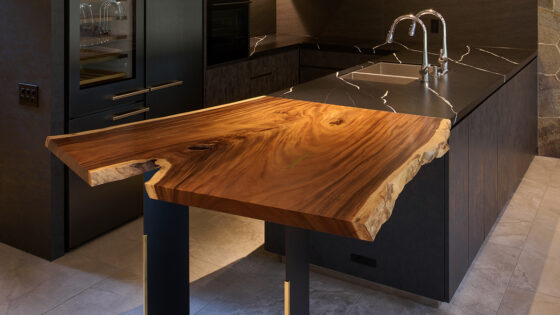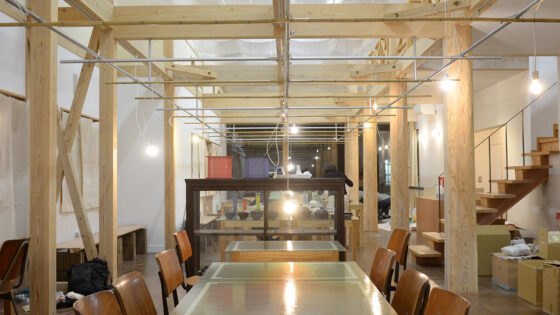HOTEL KYOTOLOGYは東山麓に位置し、近くに三十三間堂が建つ立地ではあるが、
周辺の民家や集合住宅からの視線に晒されている場所に建っている。
周囲からの視線を遮り客室への通風採光を確保すると共に
京都らしい風情を滞在者に感じてもらえる空間づくりを目指した。
京町家における坪庭は、住人だけの外部空間であり
通風・採光、石や植物が心を落ち着かせてくれ、
四季を伝えてくれる。坪庭がある日常をホテルでの体験に取り入れた。
道路斜線と、景観条例に合わせて建築のボリュームを後退させ、
容積確保の為に建ぺい率最大の4層の建築とした。
そこから容積率を満たすために坪庭(外部空間)を挿入した。
坪庭は一階から四階までの客室に合わせて様々なタイプを設け、ベッドルームとそれを正対させている。
一階は同敷地にあった灯籠、石、樹木を再構成し、二階以上は砂利と苔により京都の山々を思わせる築山で構成した。
また、全てに石と錫を組み合わせた光る錫石(アートピース)を配置し、
苔の築山と錫石は開口部からもたらされる光と共鳴し豊かな表情を生み出してくれた。
坪庭からもたらされる自然の息吹は、訪れた旅行者に京都らしい風情を提供してくれる。
The KYOTOLOGY hotel, located at the foot of Higashiyama, and within walking distance of Sanjusangen-do Temple and the Kyoto National Museum.
The hotel’s area is surrounded by private houses and middle-class condominiums, and located in direct line of sight. The idea was to keep the ventilation and natural illumination although we’ve designed the Hotel’s territory in a way that it isn’t open to anyone’s view. At the same time, we thought out ways to design the interior space, where customers could feel the atmosphere of Kyoto without relying on basic solutions, such as curtains or blinds.
We was born and raised in Kyoto, from an early age I saw a way of life in a high-density housing area. Three sides townhouses, sandwiched between other buildings, have no choice but to lean on ventilation or lighting from the facade or a small garden. The “small garden” (TSUBONIWA) in particular is an external space exclusive for the use of the guests or residents. The garden gives not only the presence of ventilation and natural illumination, but also the presence of beautifully designed stones and plants that fill the contemplator with vitality, and also serves as a kind of screen reflecting the four seasons.
We wanted to transfer the idea of everyday life with TSUBONIWA (a small garden that was developed by indigenous people of Kyoto for a long period) in order to give guests the traditional experience of Kyoto life.
According to “the setback regulation from the front road” facing the north side of the building and “the regulations of a cityscape in Kyoto” the volume of the architecture was set from the back side in the form of a staircase pattern. A four-story building was designed for a maximum capacity. But the volume ratio exceeded the upper limit, so it was necessary to reduce it to a certain degree. Therefore, giving the excess volume as TSUBONIWA for outdoor use, it was possible to maintain the volume at the required limit.
The TSUBONIWA was made in various types and designs for each room from the first to the fourth floor, so there is a view of the garden from all the bedrooms. On the ground floor there was a reconstruction of lamps, stones and trees that were at the same place before, on the second floor and above, TSUKIYAMA (築山, is an artificial mountain in a Japanese landscape garden) with the gravel and moss decorations, which are made in the shape of the Kyoto mountains. Also, luminous tin stones (objects of art), which combine stone and tin, were placed in all gardens. The moss hills combined with tin stones resonate with light, creating a rich and meaningful space.
By the openings (windows) facing TSUBONIWA (small garden), rooms view are closed to surrounding areas, while the ventilation and natural illumination are kept. The customers can enjoy the spatial experience created by exclusivity of the TSUBONIWA gardens.
The KYOTOLOGY is not a traditional Kyo-Machiya (京町家), found throughout Japan and typified in the historical capital of Kyoto. (The machiya of Kyoto are traditional townhouses dating from the Edo period (1603–1867)). The KYOTOLOGY is very comfortable and new designed hotel with the Japanese art objects.
We hope that the breath of nature emanating from TSUBONIWA will give visitors the mood of Kyoto and a relaxing stay.
設計:GENETO



